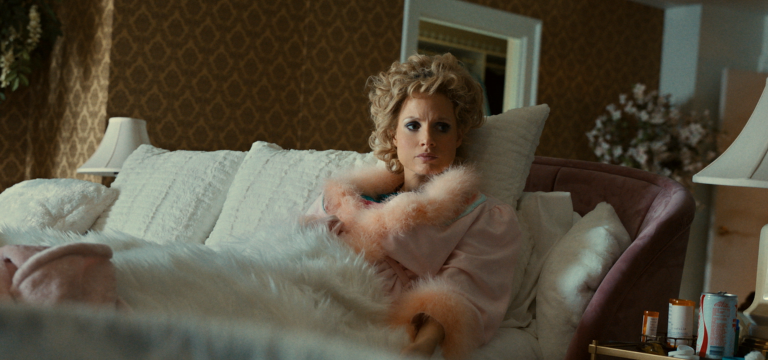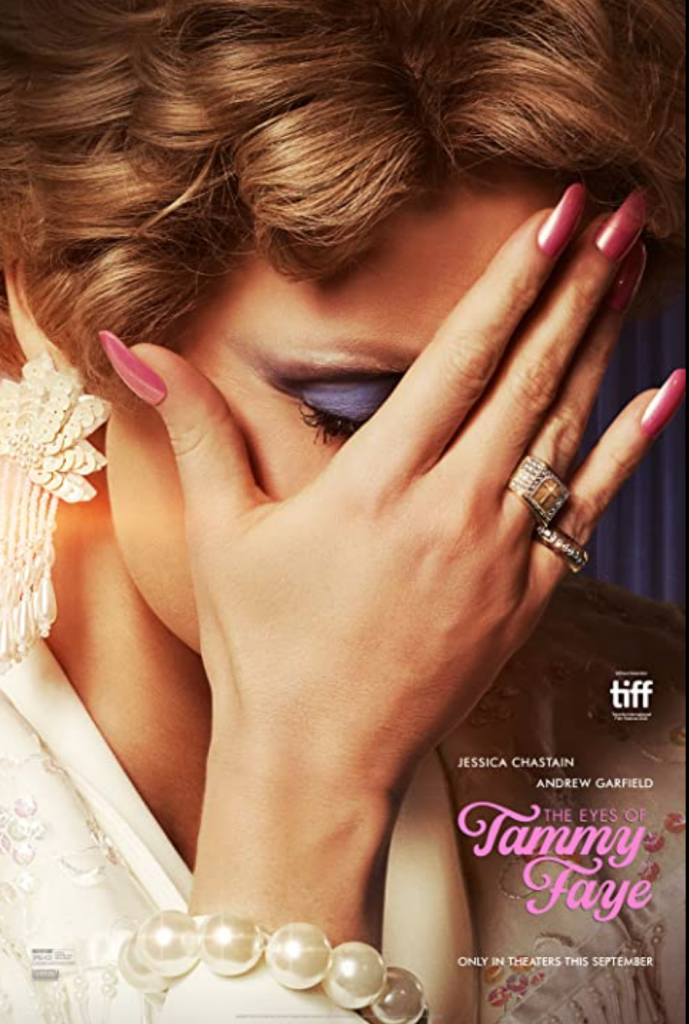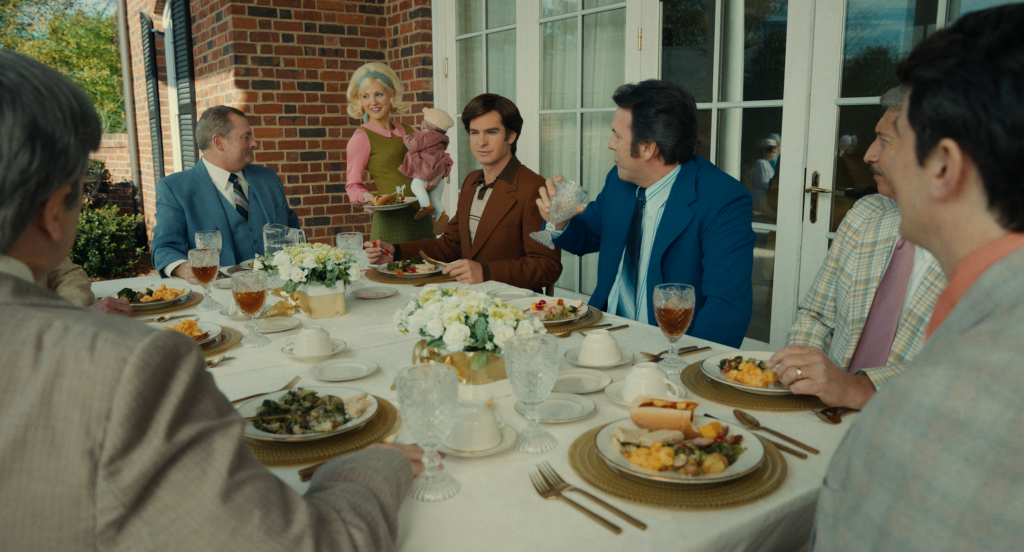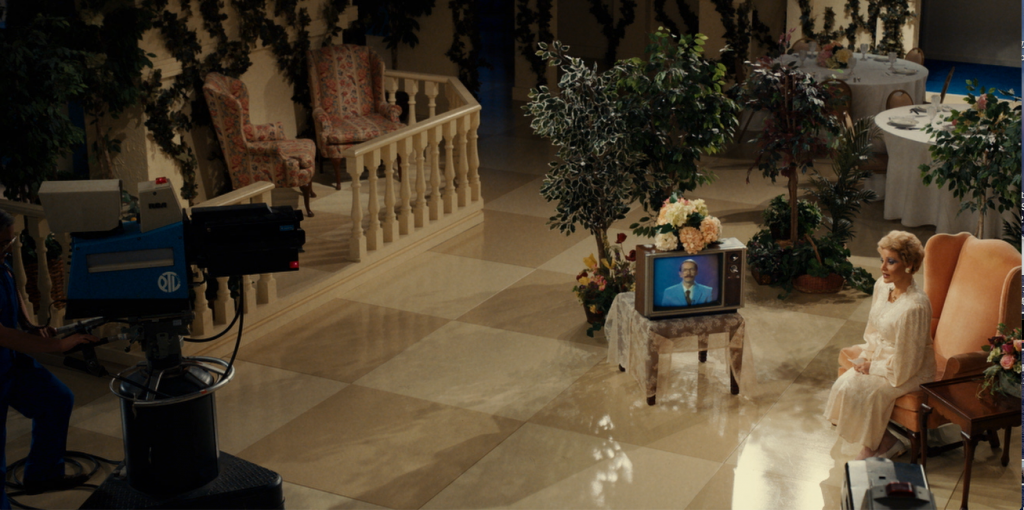
Television personalities have long been subject to criticism by the American public, but not many people know the true identities of such easily recognizable celebrities as the late televangelist-singer, Tamara Faye Bakker, who rose to fame in the mid-1960s. After watching the acclaimed 2000 documentary, The Eyes of Tammy Faye, actress Jessica Chastain decided to star in and produce a narrative feature of the same name, in order to show the title talk show host was more than just a magazine headline.
The Oscar-nominated actress-producer worked alongside screenwriter Abe Sylvia and director Michael Showalter to show in the film that Bakker had genuine integrity and faith. The new biographical drama also emphasizes that the co-founding member of The 700 Club, who rose to fame in the decades just before the internet was invented, saw how misogyny and tabloid culture played a significant role in her very public humiliation and downfall. The Eyes of Tammy Faye offers a sympathetic, emotional insight into what a profoundly compassionate woman she really was, and how she was also way ahead of her time.
Synopsis: The Eyes of Tammy Faye is an intimate look at the extraordinary rise, fall and redemption of televangelist Tammy Faye Bakker (Jessica Chastain). In the 1970s and ’80s, Tammy Faye and her husband, Jim Bakker (Andrew Garfield), rose from humble beginnings to create the world’s largest religious broadcasting network, PTL, and theme park, Heritage USA, and were revered for their message of love, acceptance and prosperity. Tammy Faye was legendary for her indelible eyelashes, her idiosyncratic singing, and her eagerness to embrace people from all walks of life. However, it wasn’t long before financial improprieties, scheming rivals and scandal toppled their carefully constructed empire.

Showalter, Sylvia, and co-stars Vincent D’Onofrio and Cherry Jones generously took the time this past month to promote the distribution of the biopic during individual exclusive interviews. Searchlight Pictures is releasing The Eyes of Tammy Faye this weekend in theaters, after had its world premiere at the Toronto International Film Festival earlier this week.
Q: Abe, you wrote the script for the new biopic, The Eyes of Tammy Faye. Why and how did you become attached to pen the screenplay for the drama?
AS: The feature is based on the documentary, The Eyes of Tammy Faye, which was narrated by RuPaul, and I was completely obsessed with when it first hit the theaters. I saw it five times at the lovely (AMC) sunset 5 (theater in West Hollywood)!
Jessica Chastaim first optioned the material. We had a prior working relationship, as I had written another script for her, so she and her producing partner brought me on, based on that material.
So when they called and asked me if I had heard of this documentary, I asked, “Have I heard of it? I own it on DVD, that’s how much I love it!”
Q: Michael, you directed The Eyes of Tammy Faye. Why were you interested in helming the film?
MS: I was interested in the character of Tammy Faye Bakker, and felt like she was someone who we, as a culture, thought we knew all of these things about, including her make-up, hair, voice and scandal. Then after seeing the documentary, and seeing there was more to her than meets the eye – no pun intended – I thought there was a really interesting character there.
Then having the opportunity to work with Jessica, who’s such a brilliant actress, appealed to me. I was really excited by the idea of telling this story with her. Having grown up in the ’80s, I had a clear image in my mind of what it could all look like.
Q: Speaking of working with Jessica, she plays the title role in The Eyes of Tammy Faye, which also stars Andrew Garfield. What was the overall casting process for the drama?
MS: Jessica is a producer on the movie, and she hired me; I didn’t hire her. She optioned the rights to the documentary awhile ago, and had been working with Abe Sylvia on the screenplay for a long time. So she was already playing Tammy Faye, and I was just brought on to direct the movie.
Andrew Garfield was also somebody they had been talking to as a possibility to play Jim Bakker, which I thought was an amazing idea. He joined the movie shortly after I did.
Q: Vincent, you play Southern Baptist pastor, televangelist and conservative activist, Jerry Falwell, who worked with the Bakkers at PTL, in The Eyes of Tammy Faye. What was it about the character, as well as the overall screenplay, that convinced you to take on the role?
VD: Jessica emailed me and asked me if I’d be interested in making this film with her, and told me a bit about it. To get a note like that from a person like her is something you take seriously because she’s a serious person.
So shortly after that I agreed and received the script. I read it, knowing that they were inviting me to play Jerry Falwell. The script was great, so it was pretty easy to agree to do it.
Q: Cherry, you play Rachel, Tammy Faye’s mother, in The Eyes of Tammy Faye. What was it about the character, as well as the overall script, that convinced you to take on the role?
CJ: I got a call out of the blue and was asked to play Jessica’s mama. I’m a big fan of Jessica’s work and knew her slightly. I was already a grown person by the time The PTL Club was on television, and we watched it just to make fun of it because they were so outrageous.
So I certainly knew Tammy Faye and Jim Bakker well, and everyone felt they knew them intimately by the end of their run. So this seemed like a fun project to star in.

Q: Abe, once you signed on to write the movie, what type of research did you do to gain a better understanding of Tammy Faye and Jim Bakker’s lives?
AS: I think I read every book on the subject. I did a deep dive and read all of the respective parties’ autobiographies and biographies. I tried to stay away from tabloids as a source, for obvious reasons. I also read a lot on evangelical doctrines, so that I got the religious aspects of the story correct. It was just several months of just reading and watching interviews before I began the process of writing.
Q: Vincent, once you signed on to star in The Eyes of Tammy Faye, what type of research did you do, besides read the screenplay, to gain a better understanding of Jerry’s life, and build your character’s arc on screen?
VD: I only knew a little bit about Jerry Falwell and the evangelist movement at the time it was happeneing. I grew up in the South, so it wasn’t completely off my radar. But I did have to take a deep dive into the research of Jerry Falwell.
So I read and learned about him on the internet, including where he was born, what his family life was like and about his education. I also read what his journey was like, up until the two different eras that we meet him in the film, because there’s a time jump.
There was also the process of recreating him and making my version of him fit into this script. That included finding video and audio files of him, which isn’t a difficult thing to do these days with the internet, and then recreating that.
That also included recreating his posture, which I studied from those videos and photographs I found. I also worked to recreate his voice and the way he would articulate and enunciate words, and brought that to the part.
Q: Cherry, once you signed on to star in The Eyes of Tammy Faye, what type of research did you do, besides read the screenplay, to gain a better understanding of Rachel’s life, and build your character’s arc on screen?
CJ: I went online to find out anything I could. For the longest time, I didn’t realize that Tammy had written an autobiography, so I didn’t have that to work with, for the most part. But I used what was in the script.
I did find a video of Rachel being interviewed for Tammy’s 40th birthday party for The PTL Club. That was a wonderful look into who she was, and what she looked and sounded like.
Bless her heart, Rachel really did have poor vision. She wore really thick glasses until she was older. I don’t know if she had eye surgery later on in life.
She had such a rough life. I can’t imagine having seven children in International Falls, Minnesota, which is one of the coldest place son the planet. They didn’t even have an indoor toilet.
So she was a hardworking woman and a divorcee during a time when it was assumed that any woman who was divorced was a harlot. She was desperate to be part of a community that didn’t approve of her. She then had this child that did not approve of.
Q: Michael, the biopic is an intimate look at the extraordinary rise, fall and redemption of Tammy Faye throughout her career. What kind of research did you do into Tammy’s life and career before you began directing The Eyes of Tammy Faye?
MS: There are all sorts of books about her. I read her autobiography, and Jim also wrote an autobiography. There are also books written about the scandal. There are all sorts of clips online from PTL that you can watch. So we were constantly, throughout the whole process, reading books and articles about her and looking at clips of her.
We also visited the actual location of where Heritage USA was in South Carolina. Fenton Bailey and Randy Barbato, who made the documentary, also gave us access to their footage.
Q: Speaking of the locations, what was the process like of deciding where you would shoot the film?
MS: We shot the movie in North Carolina. So it was really important that we tried to find locations that felt authentic and were interesting to look at, whether it was an old church, a house or the college Tammy Faye and Jim went to.
The North Carolina Film Commission were really helpful to us, in terms of finding locations that they thought would work for our shoot. We had really beautiful locations in the movie.

Q: Vincent, you mainly worked with Jessica and Andrew on The Eyes of Tammy Faye. What was the process like of collaborating with them to showcase Jerry’s relationships with Tammy Faye and Jim?
VD: I enjoyed that process very much. It’s all about the hours you put in, and doing whatever you need to do to achieve it in a free and open way. When you have actors like Jessica Chastain and Andrew Garfield in the scenes with you, you know, even before you go to do the job, that they’re going to bring something amazing to their parts because of their ability in what I’ve seen them do previously.
I knew going in it was going to be great, and that’s exactly what it was. So being in scenes with those two, as committed as they are, and have everything come together in the way that it did, was fascinating, wonderful and fun.
Q: Cherry, you mainly worked with Jessica on the drama. What was the process like of collaborating with her to showcase Rachel’s relationships with Tammy Faye?
CJ: We didn’t rehearse a lot, but instead talked a lot about the fact that it was two people who loved each other very much, but were as different as night and day. They took completely paths in life, but both had a profound faith in their God. They shared that, but very little else. Rachel, of course, wanted the approval of her religious community, while Tammy wanted the approval of her mother.
I think as the years went on, they got closer, but [spoiler alert] you don’t really see that in the film. I serve a different purpose in the film because it’s not about Tammy and her mother.
So I’m there to show the battle that Tammy had for her mother’s approval and love. Tammy would go to any lengths to get it, including moving her mother and (Rachel’s second husband,) Fred to Heritage USA. But interestingly enough, when Rachel and Fred to Heritage USA, she would only stay if she could clean hotel rooms, and Fred could have a job.
Q: Michael, what was the process like of working with the actors, particularly Jessica and Andrew, to build their characters’ relationships?
MS: They’re both thorough, hard-working actors, so they came in with all kinds of ideas about how they wanted to play their roles and what they wanted to try to accomplish. We looked at, and went through, the script, and talked about the scenes. Each one of them talked about what their character wants in each scene.
They were trying to create three-dimensional people, which tends to change how we approach things sometimes. They’d say, “I want this or that to happen,” and we’d have to work our way through it.
Both of them were creating living, breathing people. So we had to find a way to let them inhabit the world, and give them as much support as we could in order to help them make their performances possible.
Q: Abe, during The Eyes of Tammy Faye‘s shoot, did you speak with the cast, particularly Jessica and Andrew, to help answer any questions they had about their characters’ developments?
AS: Both Jessica and Andrew are cinematic treasures. I had wonderful thoughts about their particular way into the characters, and we had tight working relationships all throughout the production. I hope that shows in the final product, especially since they were able to take real ownership of the characters and play them with such conviction.
Q: Vincent, what was the process like of working with the movie’s director, Michael Showalter, to further build Jerry’s arc throughout the feature?
VD: Michael’s an amazing actor’s director, and the set he created for us was very free and open. His suggestions and directions were always good and could change a scene around.
Michael and I talked about my character. He knew that my plan was to go and do my homework the best that I know how, and bring in a full character who was going to remind people of the real Reverend Jerry Falwell. That’s what Michael wanted me to do, and that’s what I did.
On set, he created a comfortable atmosphere. Sometimes he would give me little notes that would alter a scene in a way that I hadn’t thought about. That’s always very helpful to receive from a director.
My favorite kind of director is the kind that’s as smart as Michael. So it really was about me inventing my version of Reverend Jerry Falwell, and Michael helped me do that in every way he could. We tried our best with Jessica Chastain and her amazing performance and all the incredible work that Andrew Garfield did in the film to tell the best story possible.

Q: Cherry, what was the process like of working with The Eyes of Tammy Faye’s helmer, Michael Showalter, to further build Rachel’s arc throughout the feature?
CJ: Well, Michael’s a very funny man, and his humor is very self-depreciating. But he was very clear when he thought he had what he needed, and we would move on.
My character served the part of an archetype. As written, she wasn’t a tremendously fleshed out character, nor could have it been, because she played her part so close to her chest. There’s not a shred of flamboyance about Rachel, and it’s hard when you’re playing a tough nut, and make who she is clear. I think Michael and Jessica did part of that work for me, and I just had to show up and be a tough nut and foil for the heroine of the story.
Q: Abe, what was the process like of working with the biopic’s director, Michael Showalter, to further build the title protagonist’s arc throughout the feature?
AS: It was fantastic. When Michael was brought on, he obviously had lots of thoughts about how to scale the production so that everything was achievable, and create my greatest fantasy version of the script, which isn’t always possible from a budget standpoint. So it was really about creative thinking about how we could could get the most bang for our buck on screen, and I think he did a marvelous job with the movie.
Q: Were you able to visit the set during The Eyes of Tammy Faye‘s production, and speak with Michael, Jessica and the rest of the cast and crew?
AS: I was in touch with all of them throughout the filming and editing processes. It’s wonderful when you have healthy working relationships because I think you’re always writing the movie, until the very last second. Every movie’s written three times; you’re writing it when you’re writing the screenplay, you’re writing it on the set and you’re writing it during the edit, so it was really great to be involved throughout the entire production.
Q: Michael, Tammy was known in part for her signature make-up and costumes. What was the process like of creating the title protagonist’s look?
MS: The character’s look was obviously going to be really important. That was also very much of a research thing. We found pictures of Tammy Faye from when she was a teenager all the way through her 60s. Looking at the way that her look changed from the 1950s to the ’60s, ’70s, ’80s and ’90s, and what kind of clothes she was wearing and what her hair and make-up looked like, was really helpful.
Through her clothes, hair and make-up, we tried to tell a story of what she was going through. In the ’70s, her hair was longer, and she didn’t wear as much make-up, but then in the ’80s, she cut her hair much shorter, and it was much more angler. She also wore a lot more make-up in the ’80s. So we tried to be as accurate as we could to the time period each scene was set in.
Q: Rachel, besides creating Rachel’s emotional arc throughout the film, what was the process like of creating her physicality?
CJ: It’s always fun when you have props, and glasses are one of the best props in the world to play a character; they so transform you. She had what they used to call bottle glasses because they were so thick.
The wig was also so helpful. I’ve never had a tight little 1980s bouffant church lady perm, so that was a lot of fun and did half the work for me. That’s the thing with period pieces; the costumes do so much of the work for you for telling half of the story.
Q: Michael, Tammy was legendary for her idiosyncratic singing on her religious broadcasting network. What was the process like of creating the score and musical sequences for The Eyes of Tammy Faye?
MS: The music was great, and Tammy was so passionate about her singing. Jessica did all her own singing in the movie, and recreating those songs was a lot of fun. They’re really catchy, and you can’t get them out of your head. The songs were so important to Tammy Faye, so it was really important to us that we had great music.
Q: Michael, Searchlight Pictures is releasing The Eyes of Tammy Faye in theaters today, September 17. What does it mean to you that the drama is being distributed in theaters?
MS: Searchlight Pictures is an amazing studio, and has made incredible films over the years. I was hired by them when they were ready to make the movie and were looking for a director. I jumped at the opportunity to work with them.
Q: Searchlight Pictures is releasing The Eyes of Tammy Faye in theaters today, September 17. What does it mean to you that the movie is being distributed in theaters?
AS: I think it’s every screenwriter’s dream to be able to sit down in a movie theater and see their work with an audience. You write so that your work gets made. Obviously, coming out of this year, more than ever, to be able to go to a theater and have a communal experience that’s centered on a woman who’s driven by the communal experience is amazing. Tammy Faye was about bringing people together and treating one another with love and respect. I think those are things we can really cling to this year.
Here’s the trailer of the film.

